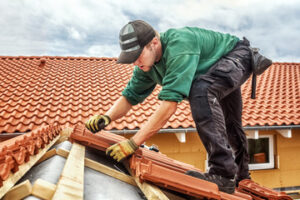Roofing is the top covering of a building which includes constructions to support it on the building walls. It protects a building from rain, snow, sunlight and extremes of temperature.

There are many different roofing materials to choose from. Each has its own pros and cons. This guide will help you weigh them against each other to find the best one for your home.
The weather can make roofing challenging, especially if the roof is high off the ground. Fog and rain decrease visibility; snow can hide potential hazards, such as skylights; strong winds can blow debris or knock loose shingles. Roofing in these conditions requires extra forethought and planning, as well as additional safety precautions in preparation, product handling and installation. Cold weather can also affect how well materials perform, though most will still work up to a certain point.
Materials
Choosing the right roofing material is a vital decision that depends on your climate, aesthetic preferences, and budget. While asphalt shingles remain the most popular roofing option, there are many different materials to choose from. Each has its own advantages and disadvantages, and each fits into certain types of homes more than others.
The most common roofing material, asphalt shingles are durable and affordable. They are available in a wide range of colors and styles, and can match the look of any home. However, they are not as energy-efficient as other roofing materials. They also have a tendency to rip, tear, and curl over time.
Rolled roofing, which is also known as mineral-surfaced or mastic roof covering, is another inexpensive roofing option. It is often used for low-sloped roofs and can be installed over existing shingles. However, it is prone to leaks because the one-piece surface does not expand and contract as easily as individual shingles.
Metal roofing is another popular choice because it is strong, durable, and long-lasting. It is also energy-efficient, as it reflects solar rays rather than absorbing them. It is also resistant to fire and insects, but it can rust over time.
Wood shingles and shakes add a rustic charm to any home. They are often made from redwood, pine, or cedar, and can be stained to match any color. They are a good choice for classic and historic homes, as well as cottages and Craftsman-style houses. However, they are prone to rot and insect infestation, and must be regularly sealed and maintained. They are also flammable, so they are banned in some areas.
Slate is a natural roofing material that is visually appealing and durable. It has a lifespan of up to 150 years, and can withstand most weather conditions better than other roofing materials. However, it is more expensive than other roofing options.
A green roof, which is a living roof covered with vegetation, is an environmentally friendly roofing option. It manages water runoff, improves air quality, and reduces heat island effect. It can be difficult to install, though, and requires regular maintenance.
Installation
The installation of a roof is the process of covering the top of a building to protect against rain, snow, sunlight, extremes of temperature, and other forces that can damage or destroy the structure. The design, materials selection, and placement of roofing are all aspects of roof construction and installation that must be carefully considered to ensure durability, longevity, and aesthetics.
The first step in roofing is to prepare the surface of the roof. This may involve repairing or replacing the existing roof, or it may simply mean ensuring that the deck is solid and free from any structural problems. Once the surface is ready, underlayment is installed. This may be a layer of felts or a tar sheet, and it is usually reinforced with either glass-fiber or organic mat. Asphalt and tar require heating before they can be applied, but cold-applied adhesives do not.
Waterproofing is also important around penetrations like chimneys, vents, and the areas where roofing planes meet (called valleys). These can be difficult to waterproof properly, but a professional roofer should be able to ensure that these are well-protected against moisture. It is also a good idea to install flashing at any gaps or joints where the roof meets a wall, to prevent leaks.
Maintenance
Regular roof inspections will catch problems early and help facilities staff determine whether to repair them in-house or hire a professional. An experienced contractor can develop a checklist specifically for each building’s needs, which will make inspections more efficient and help identify any items that need repair.
Inspect shingles for excessive wear, missing areas or deterioration; examine the integrity of the flashing around chimneys and vent pipes to prevent leaks; and look for areas where the caulking has begun to lift up, which can be easily corrected with new caulk. Checking the flashing is particularly important, as water leaks can travel sideways through the roofing and cause drywall damage below.
Also inspect stairs, crossovers, platforms and railings for structural soundness, surface deterioration and loose components. This will ensure the safety of personnel who must access the roof and may reveal a problem with the structure that could be expensive to repair.
Keep the area clear of debris, as this can clog drains and lead to premature degradation of the roofing system. Fallen limbs can also damage elements of the roof. Trimming large trees on a regular basis, especially those near the roof, can avoid this. Also, a sign posted on the roof alerting maintenance personnel of electrical, harmful chemicals or extremely hot equipment and pipes can help protect them from accidents and injury. A safe working environment will also encourage the prompt repair of any problems discovered during an inspection.